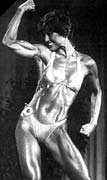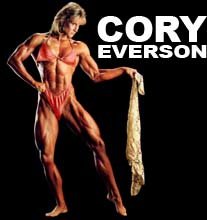There is a revolution in progress, but most people haven't noticed. This revolution is about the female body, and its most obvious manifestation is the elite, modern, female bodybuilder.

Our Culture

Our culture has celebrated the athletic male body for thousands of year. The sport of bodybuilding for men was officially created more than 60 years ago in 1940. But we have never in the past had comparable images or concepts of the strong, athletic female body. Of course, in real life, women themselves had to be strong. Most women - most people - throughout history have been farmers, and in families that worked the land women traditionally labored hard alongside their men. There was no place for a weak and pampered female when having to struggle against nature.
But while the aesthetic beauty of the male athletic body has always been a common subject of art, women have not received the same treatment. Woman was Eve, or the Virgin Mary or Venus - but the few so-called "amazons" we see in historic art tend to be what we would today describe as "beefy," and often depicted as mutilated and disfigured by the removal of a breast, supposedly to give them an advantage as archers.
What could be a better symbol of the judgement of society that women have to sacrifice their femininity if they chose to undertake activities commonly reserved to men?
However, throughout the 20th century the role of women in general began to be questioned and re-examined. Women gained the right to vote, to own property, to enter into politics, science, education and into professions long reserved for men. Toward the end of the century women began more and more to excel at sports, to the point where female Olympic athletes of today are breaking records set by men as late as the 1950s and 1960s.
But although our culture has reluctantly allowed women to redefine their roles over the past 100 years or so, there is still one barrier that has continued to resist attempts to overcome it. Society still imposes very strict limitations on what is considered acceptable as far as the female body itself is concerned - what size it should be, what shape, what body composition and how it ought to look. The standards of "femininity" imposed by society on women differ from era to era - including everything from the Rubenesque nude to the boyish, 1920s "flapper" - but in each time and place the culture dictates what kind of look is feminine and what is not.
Women are subject to this kind of evaluation even in cases in which their appearance should play no part. A male head of state, business leader or military general is rarely evaluated on the basis of whether he is good looking or "sexy." But Janet Reno, the Attorney General of the United States under President Bill Clinton - an obviously capable lawyer and law-enforcement officer - was the butt of constant derogatory jokes because it was thought her appearance was too "manly." Many of the leaders of the feminist movement that began to gather steam in the 1960s were similarly criticized. "She's only protesting because she's too homely to get a man."
On the other hand, appearing sexy, feminine and good looking can be a definite advantage to women. Pro tennis star Anna Kournikova or volley-ball player Gabrielle Reese - neither of whom have are anywhere near the top of their prospective sports - receive a disproportionate amount of attention because of their good looks.
More attractive women in general tend to find life a bit easier than do there less genetically gifted sisters. But in most sports, how you look plays little role in how well you perform. Being attractive can allow a female athlete to earn more money, to get more promotion and publicity, but not usually to win championships. But bodybuilding is different because it is all about how you look. It is a sport of visual aesthetics.

The Aesthetics Of Bodybuilding

Of course, what confuses many is that the aesthetics of bodybuilding are not those appropriate to PLAYBOY or even everyday life. Bodybuilding has its own aesthetics - in much the same way that the don't judge quality in an opera singer as you would somebody performing with a rock band. In fact, in that sense bodybuilding is in many ways the grand opera of the human body.
 All this is strange and hard for many to grasp in part because it is so new. Modern women's bodybuilding only began in the late 1970s and introduced a type of female physique almost unique to human history. This immediately challenged the social view of what is appropriate to the female body in terms of looks and physical development. Competitive bodybuilding for women or men is a sport built around creating the maximum aesthetic development of the muscles of the body. The sport requires building big muscles, but also involves, as mentioned above, aesthetic considerations such as shape, symmetry, proportion, definition and just plain beauty of line and structure.
All this is strange and hard for many to grasp in part because it is so new. Modern women's bodybuilding only began in the late 1970s and introduced a type of female physique almost unique to human history. This immediately challenged the social view of what is appropriate to the female body in terms of looks and physical development. Competitive bodybuilding for women or men is a sport built around creating the maximum aesthetic development of the muscles of the body. The sport requires building big muscles, but also involves, as mentioned above, aesthetic considerations such as shape, symmetry, proportion, definition and just plain beauty of line and structure.
There have never been female bodies like this at any time in our past. Women had never before gotten together and developed their muscles for primarily aesthetic purposes. However, as unique as this development was, in the first few years they were fairly well received.
As beginners, they weren't really very big - at least not by the standards that came to prevail less than a decade later. Many of the women who became bodybuilders in those days were quite attractive - women with good bodies who enjoyed working out and flexing on stage - and people found their little muscles "cute." But this attitude began to change as it became clear that many women had the natural genetics to develop to a level far in excess of what anyone had previously expected.
Think of it this way: Everybody likes kittens, but not everyone is fond of cats.
Over the past 20 years, women in bodybuilding have improved at a rate far faster than have the men. This tends to happen in virtually all sports in which women compete. Men are further along the "curve" of development, so face more resistance from diminishing returns. But female bodybuilders have tended to meet with a level of social resistance that most other women athletes have not had to deal with.
It seems that people often have such strong convictions regarding the female body, and gender identity as well, that they overreact when the topic of muscular women is concerned. Some respond with disgust, many with hostility and anger. They claim these women bodybuilders "look like men." They say the muscular development of female physique competitors is totally the result of using anabolic drugs (despite research that shows drug use yields no more than a percentage gain in any kind of athletic performance) rather than genetics, good technique and long years of hard training.
Oddly, this dislike of female muscle tends to be more abstract than it is specific. People often picture the least aesthetic body type in their minds when thinking about the subject, as if the occasional "troll-like" woman you see, with a squat, ugly body and lots of muscle, were somehow typical of what the best in the sport look like.
 Or they see a muscular woman in photos and don't realize how relatively small she is in real life. "I don't like those big girls, but I like you," somebody once said to attractive and shapely 6-time Ms. Olympia champion Cory Everson, not realizing that when Cory who is quite tall and a former pentathlon champion) was competing she was usually the biggest bodybuilder on the stage!
Or they see a muscular woman in photos and don't realize how relatively small she is in real life. "I don't like those big girls, but I like you," somebody once said to attractive and shapely 6-time Ms. Olympia champion Cory Everson, not realizing that when Cory who is quite tall and a former pentathlon champion) was competing she was usually the biggest bodybuilder on the stage!
Because of the hostility they have often faced, women bodybuilders have had a tough time pursuing their sport.
Even the federations that sanction female bodybuilding events seem often to be trying to hurt rather than to help these athletes. In fact, there is a degree of gender discrimination involved in bodybuilding that would be totally unacceptable in any other major sport in the world. It certainly runs contrary to the policies of the international Olympic movement, which has clear gender-equality policies.
Nonetheless, the sport has endured, the women have continued to get bigger and better, and an audience has developed around the world for female bodybuilding. This is demonstrated by the fact that my 1994 book, The Women: Photographs Of The Top Female Bodybuilders, sold more than 50,000 copies in the United States alone - and that my website at www.billdobbins.com, which features some 5000 of my photographs of physique women, became a financial success from the first day I put it on the Internet.
And the fact remains, no matter the problems faced by the competitors involved, bodybuilding for women has created a revolution in how we view the female body that is clearly manifest when we simply stop to look carefully at our culture. Consider the physique of track star Marion Jones, winner of 5 gold medals at the last Olympics. Do you think she got all those muscles just by running? No, she developed her body in the gym. And the type of muscle-exercises she used involved a system of "weight training" based on the kind of program developed by competitive bodybuilders, male and female, over the course of five or sex decades.

In Other Words...

She has built her muscles using bodybuilding, no matter what she may choose to call the type of training she does.
Despite opinions to the contrary, people like aesthetically muscular women. Actress Linda Hamilton appeared on screen in TERMINATOR II with such highly-developed arms the audience talked more about her muscles than those of co-star Arnold Schwarzenegger. Angela Bassette had muscles in WHAT'S LOVE GOT TO DO WITH IT? that Tina Turner never dreamed. Where did those movie stars get physiques like that? From doing bodybuilding. And what got them doing bodybuilding was the inspiration and example of today's competitive female bodybuilders.
Yet we constantly hear that the "general public" (that mythical beast) will not accept women with muscular bodies. If so, why was Cory Everson hired to star with Jean Claude Vandamme in an action movie not long ago? Why did Ms. Olympia Kim Chizevsky appear with Jennifer Lopez in THE CELL?
Why are teenage female athletes all over the world trying to build a body that looks like that of Marion Jones? Why did women flock to gyms and sign up for weight training after seeing Linda Hamilton and Angela Bassette on screen? Why did VOGUE Magazine put Marion Jones on its US cover? Why do all the young women hosting shows on MTV have such highly defined abdominal muscles?
 Unfortunately, image is often more important than substance. Often, how a thing is labeled changes how you perceive it. Here's an example. One of the stars of the World Wrestling Federation is a woman named Chyna. She is considered a "sex symbol" in the WWE, to the point where PLAYBOY just did a feature on her in the US edition and even put her on the cover.
Unfortunately, image is often more important than substance. Often, how a thing is labeled changes how you perceive it. Here's an example. One of the stars of the World Wrestling Federation is a woman named Chyna. She is considered a "sex symbol" in the WWE, to the point where PLAYBOY just did a feature on her in the US edition and even put her on the cover.
This was considered acceptable marketing because she is labeled as a "wrestler." However, Chyna developed that physique as a bodybuilder. PLAYBOY is usually very much anti-female muscle, but in their eyes Chyna the wrestler is acceptable to the general public. Chyna the bodybuilder - with the same physique - would not be. A question of labels.
Nonetheless, it is clear that female bodybuilders have created a revolution, one that is having a widespread affect on our ideas, perceptions, and our culture. Yet they themselves are not getting credit for this revolution and not receiving much benefit from it.
Hopefully, this situation will soon change and they will get the recognition they deserve - as athletes, as beautiful women, as pioneers exploring the genetic potentials of the female body, and as role models helping other women to realize that "femininity" and a strong, healthy body can coexist.
If women bodybuilders don't get this recognition and credit, others will continue to benefit while their achievements will go un-rewarded. They will be, in effect, like Moses - leading the chosen to the Promised Land, but being denied entry to it themselves.
About The Author
Bill Dobbins has co-authored three books with Arnold Scwharzenegger, including Arnold's New Encyclopedia of Modern Bodybuilding (Simon & Schuster). His photographs of muscular women can be seen in two books, Amazon Women (Taschen) and The Women: Photographs of the Top Female Bodybuilders (Artisan). More of his photos and his writings about women's bodybuilding and muscular female physiques appear on his websites: The Female Physique Webzine/Gallery (www.billdobbins.com) and The Female Physique Art Gallery (www.billdobbins.net).
Fitness Olympia Judging: A Closer Look!
Thanks,
